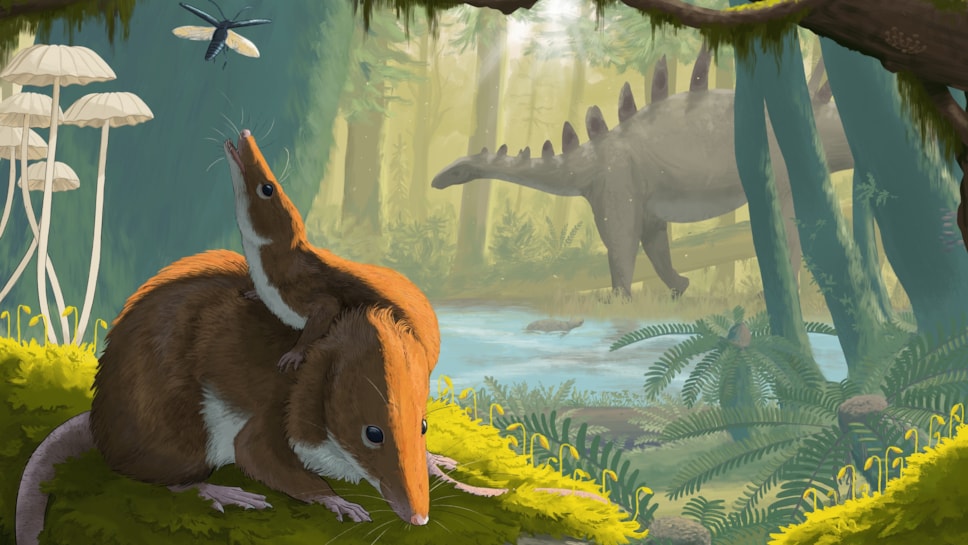
Fossil discovery reveals mammals grew more slowly in the Jurassic than they do today
Two unique Jurassic fossil discoveries from the Isle of Skye have shown that mammals in the time of the dinosaurs grew more slowly and lived longer than mammals today.
Press images are available here.
Video available for press use includes:
- Interview with Dr Elsa Panciroli and b-roll of the Krusatodon kirtlingtonensis fossils
- A packaged edit
- A social media cut
A new study in Nature by an international team of researchers led by National Museums Scotland describes two Krusatodon kirtlingtonensis fossils, one adult and one juvenile, both discovered in Skye. These mouse-sized mammals lived around 166 million years ago. The specimens represent the only juvenile Jurassic mammal skeleton known to science, while the adult is one of the most intact mammal skeletons from this time period in the world.
The discovery of a juvenile and adult of the same species of early mammals is unique and has allowed groundbreaking comparative analysis into their growth and life history. The ages of the specimens at death were determined using X-ray imaging to count the growth rings in their teeth. The adult was found to be around 7 years old and the juvenile between 1 - 2 years, and still in the process of replacing its baby teeth. This was possible thanks to X-ray computed tomography carried out in several laboratories, including the European Synchrotron (ESRF).
Today, small mammals have significantly shorter lifespans, some living as little as 12 months, and maturing quickly, losing their baby teeth and weaning within months of birth. The Krusatodon fossils reveal for the first time that the earliest mammals didn’t finish replacing their teeth until well into their second year of life, possibly later. This tells us that a fundamental shift in the growth patterns and life expectancy of mammals must have taken place during or after the Middle Jurassic.
The specimens were discovered decades apart, with the adult being one of the earliest Jurassic finds on Skye in the 1970s, while the juvenile was discovered in 2016.
Dr Elsa Panciroli, lead author and Associate Researcher of Palaeobiology at National Museums Scotland, said:
“These fossils are among the most complete mammals from this time period in the world. They give us unprecedented insights into the lives of the first mammals in the time of dinosaurs. Although on the outside Krusatodon looked like a shrew or mouse, on the inside it was quite different; it grew more slowly and lived much longer than small mammals do today. As a result, it probably had quite a different physiology and life history as well. Skye’s fossils are really putting Scotland firmly on the map when it comes to understanding mammal evolution. This is just the tip of the iceberg in terms of what they can tell us.”
Dr Stig Walsh, Senior Curator of Vertebrate Palaeobiology at National Museums Scotland and co-author on the study, said:
“Even in the context of the amazing palaeontological finds on Skye in recent years, these fossils are remarkable. Mammal fossils of this age are exceptionally rare worldwide, and most are just single teeth found by sieving sediment. To find two such rare fossil skeletons of the same species at different growth stages has rewritten our understanding of the lives of the very earliest mammals. We’re thrilled they are both now part of Scotland’s National Collection, an important part of the global fossil record, and will be preserved for generations of researchers to come.”
In addition to National Museums Scotland, the study also involved researchers from the American Museum of Natural History, University of Chicago, European Synchrotron Radiation Facility, and Queen Mary University of London.
Prof. Roger Benson from the American Museum of Natural History said of the fossil found in 2016:
“When we found the tiny juvenile skull I didn’t realise what we’d found right away. The part of the fossil that was sticking out of the rock was blasted by erosion, surrounded by barnacles, and looked just like a piece of ash. I used micro-CT scanning, a form of 3D X-ray imaging, and was very surprised to see a whole skull in the rock. For science, it’s really remarkable to have this fossil and it told us a lot about growth and life history in some of the earliest mammals”
Dr Elis Newham, a Postdoctoral Research Associate at Queen Mary University of London said:
"Our study benefited greatly from a new technique we developed using synchrotron X-ray technology. This allowed us to analyse growth patterns in the teeth of these fossils, much like counting tree rings. It was surprising to discover that Krusatodon, while showing a similar development pattern to modern mammals, grew much slower and lived longer. This research emphasises the value of studying juvenile fossils, and the X-ray cementochronology technique offers a powerful tool for unlocking these secrets from the past."
The paper is published in Nature today, 24 July 2024.
Notes to editors
- National Museums Scotland is one of the leading museum groups in the UK and Europe and it looks after collections of national and international importance. The organisation provides loans, partnerships, research and training in Scotland and internationally. Our individual museums are the National Museum of Scotland, the National Museum of Flight, the National Museum of Rural Life and the National War Museum. The National Museums Collection Centre in Edinburgh houses conservation and research facilities as well as collections not currently on display.
Twitter: @NtlMuseumsScot
Facebook: www.facebook.com/NationalMuseumsScotland
Instagram: @NationalMuseumsScotland
- Bheireadh Oifis nam Meadhanan eadar-theangachadh Gàidhlig den bhrath-naidheachd seachad do bhuidhinn mheadhanan bharantaichte. Cuiribh fios do dh'Oifis nam Meadhanan airson bruidhinn air cinn-latha freagarrach.
